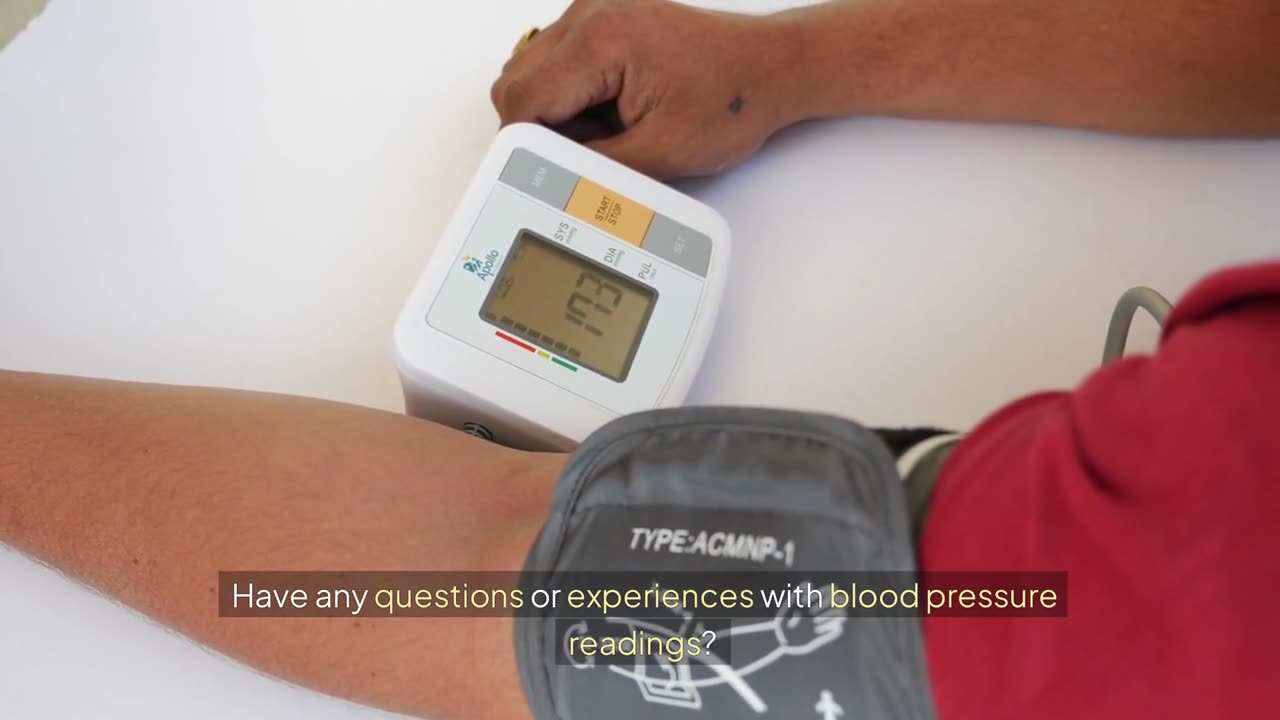Premium Only Content

How Your Arm Position Can Affect Blood Pressure Measurements: What You Need to Know*
**Introduction:**
Have you ever wondered why your blood pressure readings seem to fluctuate between doctor visits? A recent study has revealed that the position of your arm during a blood pressure test can significantly influence the outcome. This seemingly small detail could be the difference between a healthy reading and a diagnosis of hypertension. Let’s dive into how this happens, what the study found, and why it matters for your health.
**Section 1: The Importance of Accurate Blood Pressure Readings**
Blood pressure measurements are a fundamental part of every medical checkup. These readings help gauge the force of blood flowing through your arteries and play a crucial role in diagnosing and managing conditions like hypertension (high blood pressure), which affects millions worldwide. But what happens if your blood pressure reading is inaccurate?
Hypertension is often dubbed the "silent killer" because it can lead to serious health complications like heart attacks, strokes, and kidney failure without any obvious symptoms. If you’re misdiagnosed with high blood pressure due to improper measurement techniques, you may end up taking medication you don’t need. On the flip side, if your blood pressure is underestimated, you could be at risk of untreated hypertension. That’s why understanding the role of arm positioning in these readings is so important.
**Section 2: The New Study—What Researchers Discovered**
A new study published in *JAMA Internal Medicine* has shed light on the impact of arm positioning during blood pressure tests. Researchers tested 133 adults aged 18 to 80 by measuring their blood pressure in three different arm positions:
1. Arm supported on a desk (the gold standard).
2. Arm resting on the lap.
3. Arm hanging unsupported by the side.
The findings were striking. Blood pressure readings taken with the arm resting on the lap or hanging by the side were consistently higher than when the arm was properly supported on a desk. In fact, the difference in systolic pressure (the top number in a blood pressure reading) was as high as 6.5 mmHg when the arm was left unsupported at the side. This could mean the difference between a normal reading and a diagnosis of stage 2 hypertension.
**Section 3: How Arm Positioning Affects Blood Pressure**
But why does arm position matter so much? Blood pressure is the force of blood against the walls of your arteries, and it can be influenced by various factors—including the position of your body and limbs. When your arm is not properly supported at heart level, gravity comes into play. An unsupported arm hanging by the side causes the muscles to tense and the pressure in the arteries to rise, leading to a falsely elevated blood pressure reading.
Similarly, when the arm rests on the lap, it’s positioned lower than heart level, causing a less significant—but still noticeable—overestimation of blood pressure. The correct position, as recommended by the American Heart Association (AHA), is with the arm supported on a flat surface at heart level. This positioning ensures that the reading accurately reflects the pressure in your arteries without external influences.
**Section 4: What This Means for Hypertension Diagnosis**
The findings of this study are particularly important for diagnosing hypertension. Hypertension is defined as a blood pressure reading consistently above 130/80 mmHg. Misdiagnosis can occur when readings are higher than they should be due to incorrect arm positioning.
For instance, an overestimation of 6.5 mmHg in systolic pressure can turn a reading of 123 mmHg (which is within the normal range) into 130 mmHg, potentially putting you into the "elevated" blood pressure category. Worse, a reading of 133 mmHg could be misread as 140 mmHg, crossing the threshold into stage 2 hypertension, which would typically prompt immediate treatment or medication.
The consequences of such a misdiagnosis could be profound. Overdiagnosis may lead to unnecessary medications, which can have side effects and cause undue stress. Conversely, underdiagnosis may leave serious conditions untreated, allowing hypertension to silently damage your cardiovascular system.
**Section 5: Ensuring Accurate Readings at Home and in Clinics**
The study's findings suggest that many clinicians may not be following best practices when measuring blood pressure. Typically, in doctors’ offices, patients sit on an exam table with their arm unsupported, which is not ideal. This practice could lead to overestimated readings, affecting treatment decisions.
The AHA guidelines for blood pressure measurement are clear:
- Use an appropriately sized cuff.
- Support the patient’s back.
- Ensure their feet are flat on the floor, legs uncrossed.
- Most importantly, position the arm at heart level on a flat surface.
When these conditions are met, blood pressure readings are more accurate and reliable. If you’re measuring your blood pressure at home, make sure to follow these same guidelines. Investing in a reliable home blood pressure monitor and taking readings at the same time each day can help you get a clearer picture of your heart health.
**Section 6: Implications for Health Care Providers and Patients**
The study's lead author, Sherry Liu from Johns Hopkins Bloomberg School of Public Health, emphasized the importance of paying closer attention to arm positioning during blood pressure screenings. While the study only tested automated blood pressure devices, the findings likely apply to manual devices as well. Healthcare providers should be mindful of these guidelines to prevent misdiagnosis and ensure proper patient care.
For patients, it’s important to be aware of these best practices and advocate for yourself during doctor visits. If your arm isn’t supported at heart level during a blood pressure reading, don’t hesitate to ask for adjustments. Your health depends on accurate data, and a small change in how your blood pressure is measured can make a big difference.
**Conclusion: Small Changes, Big Impacts**
This new study shows that something as simple as arm positioning can significantly affect blood pressure readings and, by extension, your health. Whether you’re visiting your doctor or checking your blood pressure at home, it’s crucial to ensure that your arm is properly supported at heart level. Accurate readings are the foundation of diagnosing and managing hypertension, so don’t overlook the importance of this small detail.
To stay informed about your health and learn more about topics like this, don’t forget to like, share, and subscribe to our channel. Your engagement helps us bring you more valuable health insights. Have any questions or experiences with blood pressure readings? Drop a comment below, and let’s start a conversation!
-
 6:46:07
6:46:07
Rance's Gaming Corner
10 hours agoTime for some RUMBLE FPS!! Get in here.. w/Fragniac
131K1 -
 1:30:48
1:30:48
Josh Pate's College Football Show
10 hours ago $4.49 earnedCFP Reaction Special | Early Quarterfinal Thoughts | Transfer Portal Intel | Fixing The Playoff
31.4K -
 23:55
23:55
CartierFamily
3 days agoElon & Vivek TRIGGER Congress as DOGE SHUTS DOWN Government
111K100 -
 5:43:44
5:43:44
Scammer Payback
2 days agoCalling Scammers Live
182K25 -
 18:38
18:38
VSiNLive
2 days agoProfessional Gambler Steve Fezzik LOVES this UNDERVALUED Point Spread!
135K17 -
 LIVE
LIVE
Right Side Broadcasting Network
10 days agoLIVE REPLAY: President Donald J. Trump Keynotes TPUSA’s AmFest 2024 Conference - 12/22/24
3,499 watching -
 4:31
4:31
CoachTY
1 day ago $27.90 earnedCOINBASE AND DESCI !!!!
180K11 -
 10:02
10:02
MichaelBisping
1 day agoBISPING: "Was FURY ROBBED?!" | Oleksandr Usyk vs Tyson Fury 2 INSTANT REACTION
101K14 -
 8:08
8:08
Guns & Gadgets 2nd Amendment News
2 days ago16 States Join Forces To Sue Firearm Manufacturers Out of Business - 1st Target = GLOCK
123K89 -
 10:17
10:17
Dermatologist Dr. Dustin Portela
2 days ago $18.75 earnedOlay Cleansing Melts: Dermatologist's Honest Review
159K14